With developments such as AIS, Bluetooth and DSC, as well as battery technology and improvements in waterproofing, handheld VHF radio's now offer more than ever before. But all of these features come with costs including size, weight and battery life as well as your hard earned cash. As a sea kayaker, working out which is the best VHF radio for your specific requirements can be difficult but we have tried to simplify that with our Buyers Guide to Handheld VHF radios for Sea Kayakers.
Disclosure: Sea Kayak Paddler is supported by it's readers. When you buy through links on this page we may earn commission. As an eBay Partner Network Affiliate, we earn from qualifying purchases.
Cobra HH150
Budget, Floats and AA Batteries.
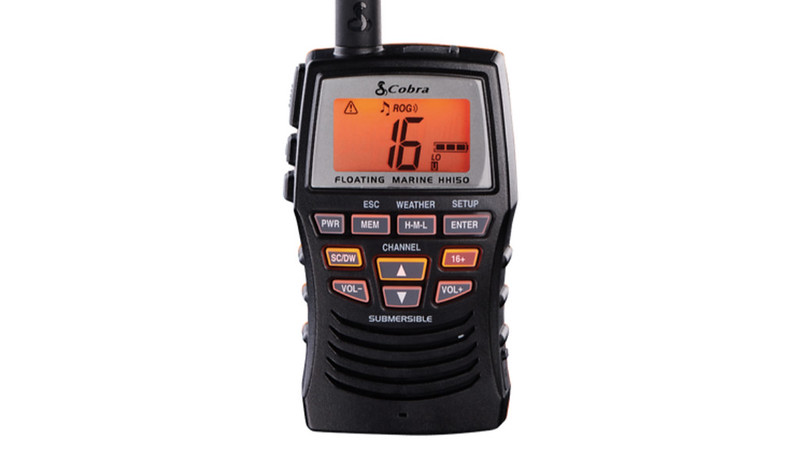
The Cobra HH150 is a budget, compact, waterproof and floating handheld VHF. With 3W of transmission power its range is less than other radios and its speaker output is very quiet but these specs help it give longer usage times to its conveniently replaceable or rechargeable, but not very powerful, 5 NiMH AAA batteries.
Key Specs and Features:
- RRP: £109.99
- Waterproof: IPX7
- Float+Flash: Yes+No
- Transmit Power: 3W
- AF output: 250 mW
- Battery: 5xAAA
- Charging: USB
- DSC + GPS: No
- Dimensions: 114x69x38mm
- Weight: 227g
- Warranty: 2 years
Check price at: Amazon (UK) and Ebay (UK)
Standard Horizon HX40
Compact, Powerful and Long Life Battery.
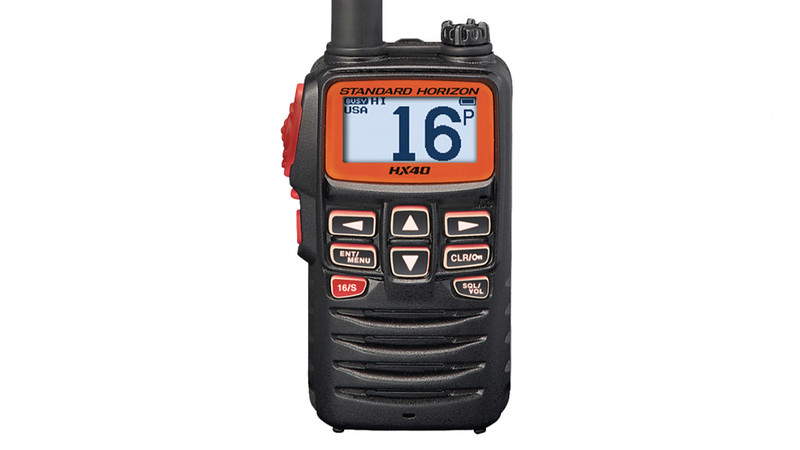
The Standard Horizon HX40 is a tiny but mighty VHF radio which packs a powerful 6W of transmission, has a useful battery-save function, easy to read menu and a reasonable cost but perhaps its best feature for sea kayakers is its ultra compact size which makes it so convenient to keep it in your PDF pocket. It's Lithium Polymer battery holds its charge much better than Lithium Ion battery's, particularily when its not being used.
Key Specs and Features:
- RRP £131.95
- Waterproof: IPX7
- Float+Flash: No
- Transmit Power: 1/2.5/6W
- AF output: 600 mW
- Battery: 1850mAh Li-po
- Charging: USB
- DSC+GPS: No
- Dimensions: 95 x 52 x 33mm
- Weight: 230g
- Warranty: 3 years
Check price at: Amazon (UK) and Ebay (UK)
Icom M25
Slim and Floats.
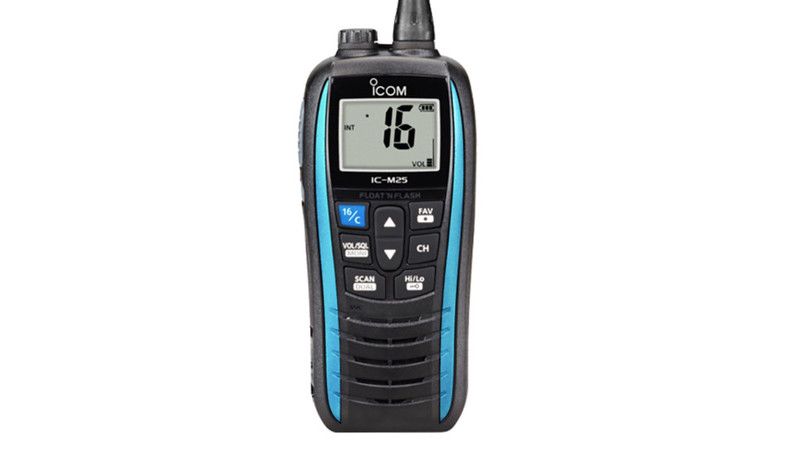
This lightweight and simplified VHF handheld radio is slim and tapered so that you can more easily store in the slim pockets often found in centre zipped PFD's. As well as floating, it has an impressive battery life for its size and transmition strength, and is good value for money.
Key Specs and Features:
- RRP: £179.99
- Waterproof: IPX7
- Float+Flash: Yes
- Transmit Power: 5W
- AF output: 550 mW
- Battery: 1500mAh Li-ion
- Charging: USB
- DSC+GPS: No
- Dimensions: 134x57×3mm
- Weight: 225g
- Warranty: 3 years
Check price at: Amazon (UK) and Ebay (UK)
Icom M37
Big Battery.
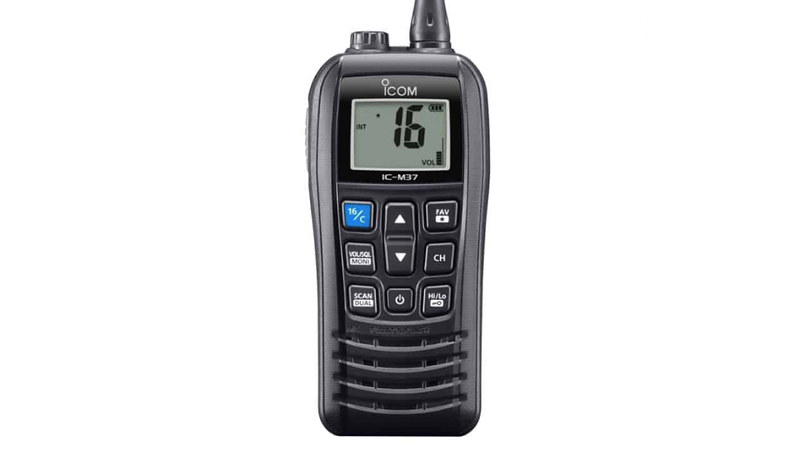
This handheld VHF unit is a real workhorse. It is designed for both the leisure and commercial market. Its standout feature's are its transmission power and its battery capacity that gives better battery life than other handheld radios. However it is big and heavy and is expensive for a unit that has no DSC/GPS.
Key Specs and Features:
- RRP: £218.74
- Waterproof: IPX8
- Float+Flash: Yes
- Transmit power: 1/6W
- AF output: 700 mW
- Battery: 2350 mAh Li-ion
- Charging: Drop in cradle
- DSC+GPS: No
- Dimensions: 121x67x53mm
- Weight: 299g
- Warranty: 3 years
Check price at: Amazon (UK) and Ebay (UK)
Standard Horizon HX890
Expert Features.
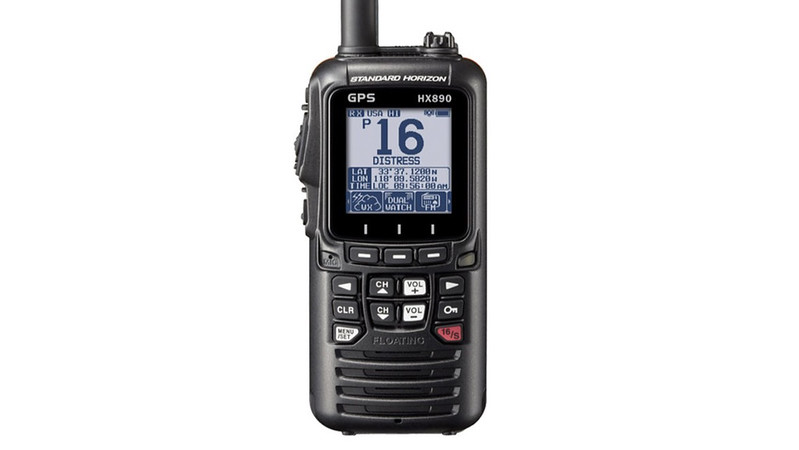
As well as being powerful, very waterproof and floating, this top end VHF is packed with features such one button distress call, DSC calling, position sharing, waypoint navigation and navigation to DSC distress calls. It can also track and display position information of up to 9 other pre-selected DSC radios. It has noise cancellation function on both the transmitting and receiving audio. All these features come at a cost though, both financially and physically as this unit is expensive as well as big and heavy.
Key Specs and Features:
- RRP: £246.95
- Waterproof: IPX8
- Float+Flash: Yes (Flash can be turned off)
- Transmit Power: 1/2/6W
- AF output: 700 mW
- Battery: 1800mAh Li-ion
- Charging: Drop in cradle + AA battery tray
- DSC+GPS: Yes
- Dimensions: 138x66x38mm
- Weight: 310g
- Warranty: 3 years
Check price at: Amazon (UK) or Ebay (UK)
Cobra HH600
Bluetooth phone connectivity.
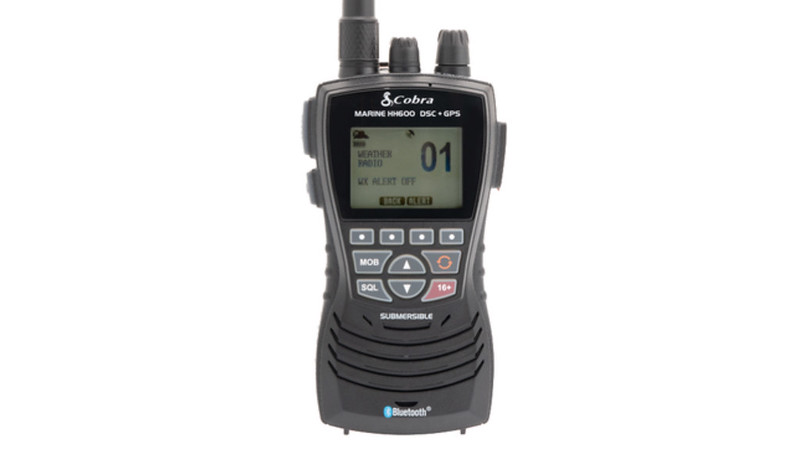
A unique feature of this VHF is bluetooth. This means you can have your phone packed away nice and dry in your boat and still be able to make calls. Another innovative feature, seen middle right on the unit keypad, is the rewind-say-again button. This continually records and allows you to quickly re-listen to the previous 20 seconds, a useful feature due to this units very quite speaker. This feature rich VHF does drain its big and heavy battery quickly though and it's display isn't the clearest to read.
Key Specs and Features:
- RRP: £279.99
- Waterproof: IPX8
- Float+Flash: Yes+No
- Transmit Power: 1/3/6W
- AF output: 250 mW
- Battery: 2000 mAh Li-ion
- Charging: Drop in cradle + AA battery tray
- DSC+GPS: Yes
- Dimensions: 131x72x47mm
- Weight: 329g
- Warranty: 2 years
Check price at: Amazon (UK) or Ebay (UK)
ICOM M94D
Integrated AIS.
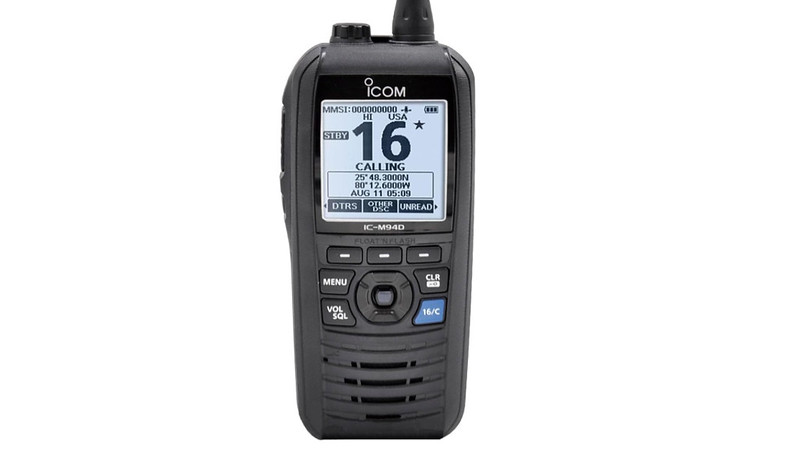
The Icom M94D is the flagship handheld VHF from Icom and as such is full of features. It is the first handheld VHF radio with AIS (Automatic Identification System). This uses an AIS transponder and GPS to broadcasts information such as position, speed and heading over VHF waves. This information can be viewed by any other AIS equipped units, as well as on any computer or smartphone linked to the internet. It has a very loud speaker and also features active noise canceling when transmitting. These features come at a cost though and also require a big and heavy battery.
Key Specs and Features:
- RRP: £362.80
- Waterproof: IPX7
- Float+Flash: Yes
- Transmit Power: 6W
- AF output: 1500 mW
- Battery: 2400 mAh Li-ion
- Charging: Drop in cradle + AA battery tray
- DSC+GPS: Yes
- Dimensions: 146×61x44mm
- Weight: 357g
- Warranty: 3 years
Check price at: Amazon (UK) and Ebay (UK)
Features to Know
Waterproof - The use of keypads make waterproofing radios easier, eliminating the problem of worn O-rings on rotary knobs. Drop in cradle charging also eliminates the potential leak point of an charging port. IPX7 is protected against water immersion for 30 minutes at a depth of 1 meter. IPX8 is protected against continual water submersion at a depth of over 1 meter.
Float + Flash - Floating is undoubtably a handy feature but it requires the VHF to be bigger than would otherwise be necessary. The Flashing feature refers to a 'water activated strobe' that will flash a light if the unit gets wet. While this is a useful feature if you drop your VHF in the water at night, it can drain the battery if the sensor gets wet.
Transmit Power - This is the amount of electrical power used for the transmission of the call. While this does increase the drain on the battery when transmitting it improves the distance that the signal can be picked up from. The range of handheld VHF's units is poor though, as a rule of thumb for one sea kayaker to another it is a mile per watt, so 3 miles for 3W and 6 miles for 6W. A large and powerful aerial, such as the Coastguard's, can pick up the signal from much further, typically 20-30 miles.
AF Output - This translates as the maximum volume of the speaker and is important for hearing the transmitted message in loud and noisy environment's. Noise cancellation on the received transmission also helps here. Noise cancellation on the transmitter signal helps the receiver hear more clearly.
Battery - Whilst there are industry standards for measuring battery life with handheld VHF's they don't take into account the more recent features such as GPS, Bluetooth and AIS, which all have high demands on the battery when being used. Sea kayakers however will often turn off these features when not needed to save power. The best measure therefore is the battery capacity.
The composition of batteries affects how they behave too. Nickel Cadnium (Ni-Cad) batteries have a 'memory effect' where they have to be fully discharged before being recharged or they will not hold as much. Lithium Ion batteries (Li-ion) don't have as strong a memory effect but they self-discharge at about 5-10% per month. Lithium polymer (Li-Po) batteries are newer technology. These batteries are lighter and thinner, have less memory and can be stored for up to two months without significant loss of charge.
Charging - While USB ports are a potential leak point they do mean you can charge your radio using a universal battery pack and cable when on expeditions. Drop in cradle means no port but a bulkier charging setup. The contact points that connect with the cradel on older units tended to corrode but most mainstream manufactures seem to have sorted this on newer models.
DSC+GPS - DSC (Digital Selective Calling) can be paired with GPS (Global Positioning System) to allow the user, with the press of a button, to transmit an alert with vessel information and position to other DSC-equipped units and rescue facilities.
Operating Area - VHF's are built for two main operational areas, International (which includes Europe) and the USA and Canada. International (and European) compatable model numbers often end with the addition of Euro or E. Radios set for the incorrect area will work, they just wont have access to all the channels.

By Philip Clegg
With over two decades of working in the sea kayaking industry, Phil can be found on a daily basis coaching on the sea around Anglesey. That's when he's not researching and writing on all things sea kayaking.

